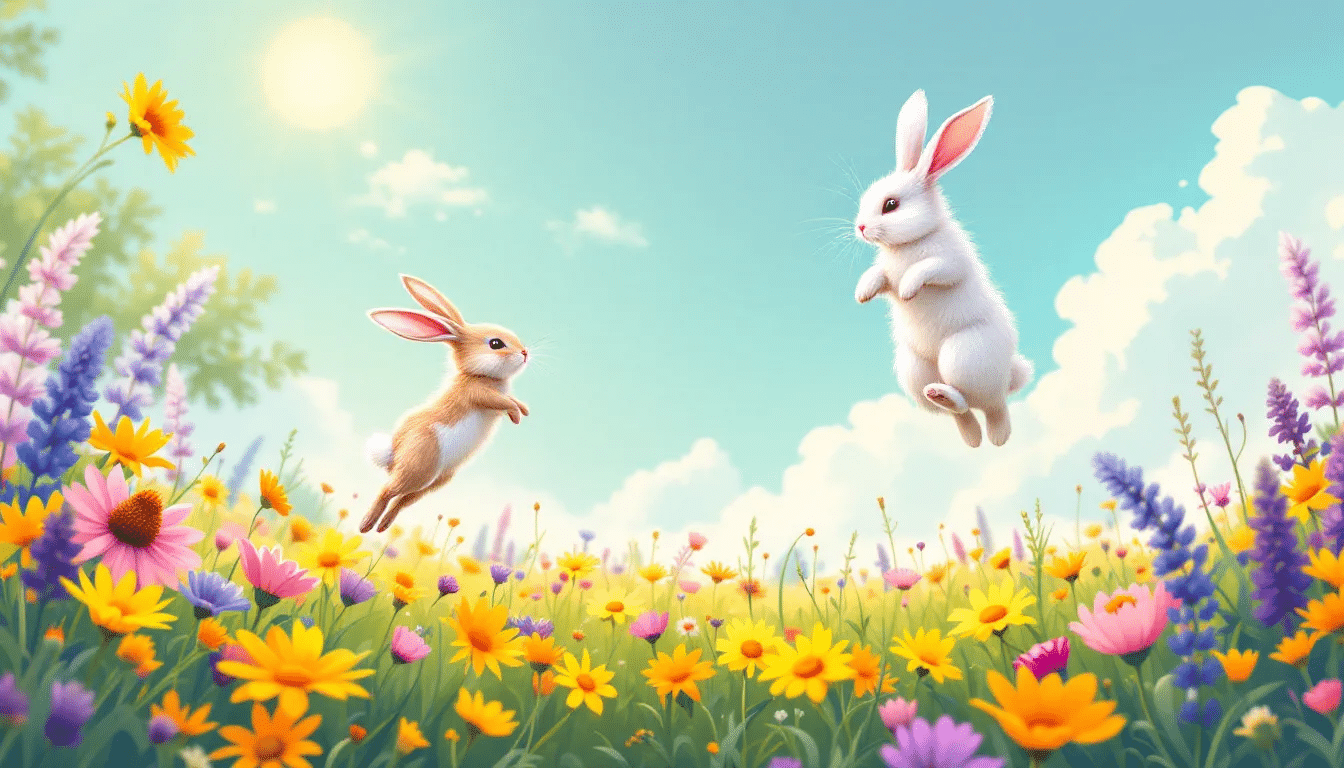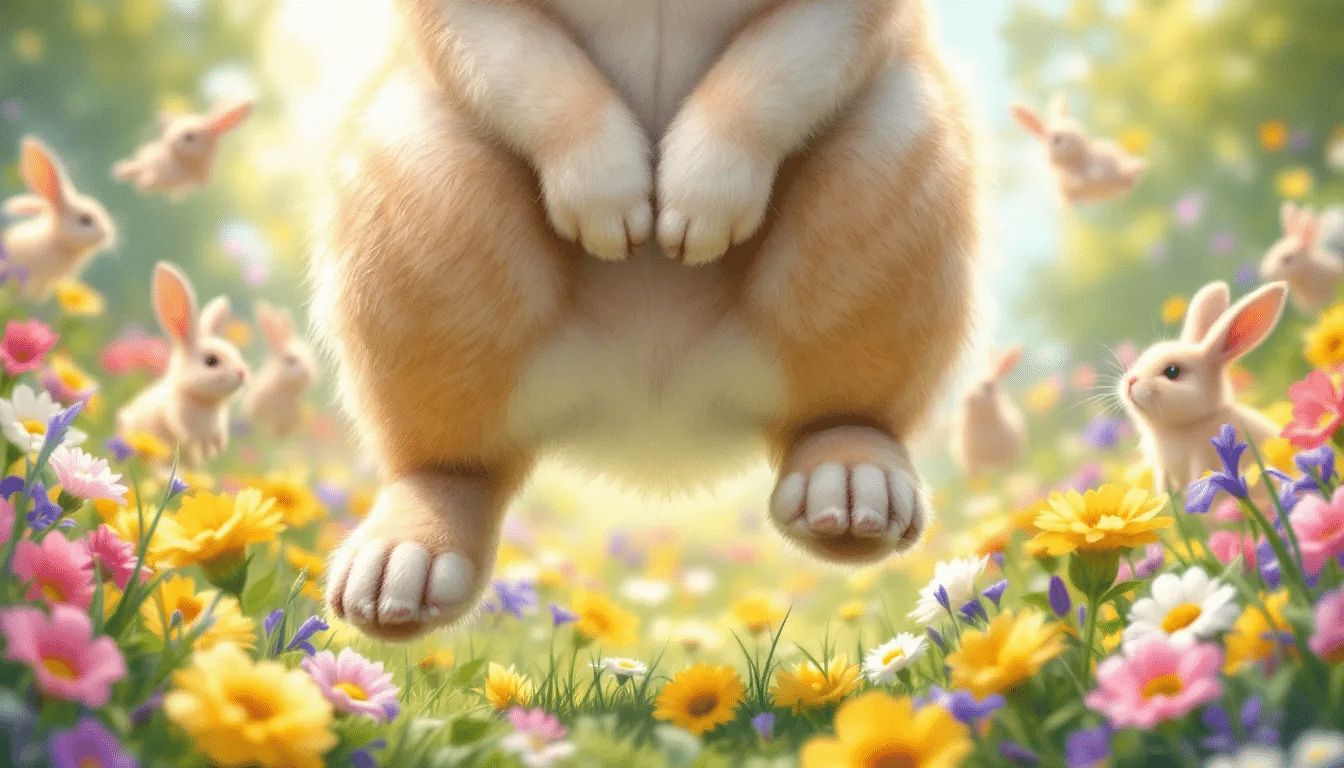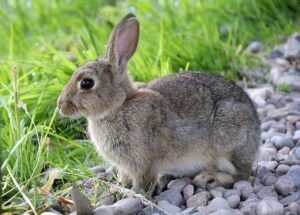How high can a pet rabbit jump? Most pet rabbits can jump between 2 to 4 feet high. Variations in jumping height depend on factors like breed, age, and health. In this article, we’ll explore these factors, along with tips for training and maintaining your rabbit’s jumping abilities.
Key Takeaways
- Pet rabbits can jump between 2 to 4 feet high, with factors like breed, age, and health influencing their capabilities.
- Agile rabbit breeds, such as the Belgian Hare, can jump higher than larger breeds like the Flemish Giant due to physical differences.
- Training environments should be safe and secure, promoting healthy jumping habits while avoiding risks of injury.
Average Jump Height of Pet Rabbits

Most rabbits can jump between 2 to 4 feet high, with healthy rabbits typically achieving jump heights of around 2 to three feet. This variation depends on factors such as breed, health, and age, which we’ll explore further.
Factors Influencing Jumping Ability
Several factors influence a rabbit’s jumping ability, including breed, age, health, and weight. Younger, healthier rabbits can typically jump higher than their older or less healthy counterparts. For example, a young, fit rabbit can easily out-jump an older rabbit with health issues like arthritis.
Extra weight can also hinder a rabbit’s jumping ability. Different breeds exhibit varied jumping capabilities due to their unique physical traits. Some breeds are naturally more agile and can jump higher because of their lightweight skeletal structures and muscular build.
World Records for Rabbit Jumps
The highest recorded jump by a rabbit is an astonishing 3 feet, 3 inches, set by Mimrelunds Tösen in 1997. This feat showcases the extraordinary potential of rabbits to jump higher than most people expect. The record height of 39.2 inches demonstrates the remarkable athleticism of these animals.
These records highlight the impressive athleticism found in some rabbit breeds, showing that rabbits can achieve incredible heights. Rabbits are also notorious escape artists, and their impressive jumping ability can make it challenging to contain them.
Rabbit Breeds and Their Jumping Capabilities

Rabbit breeds vary significantly in their jumping abilities, influenced by factors like size and physical condition. Breeds such as the Belgian Hare and Netherlands Dwarf are notable for their agility and impressive jumping abilities.
Larger breeds such as the Flemish Giant and Holland Lop generally do not jump as high due to their bulkier structure.
Agile Breeds vs. Larger Breeds
Agile breeds like the Belgian Hare can jump up to 4 feet high, thanks to their powerful hind legs and lightweight build. In contrast, larger breeds like Flemish Giants may only reach 2 to 3 feet due to their bulkier structure.
This difference in jumping capabilities showcases the variety within rabbit breeds and how their physical traits impact their leaping abilities.
How Age and Health Impact Jumping
Younger rabbits generally display greater strength and agility, allowing them to jump higher compared to older rabbits or those facing health challenges. As rabbits age, their muscle strength decreases, significantly impacting their jumping ability.
Maintaining your rabbit’s health throughout its life can help preserve its natural jumping prowess.
Training Your Pet Rabbit to Jump

Training your pet rabbit to jump enhances its physical health, provides mental stimulation, and strengthens your bond. Positive reinforcement methods, such as treats and praise, can be highly effective in teaching your rabbit to jump safely and confidently.
Rabbits jump higher when they feel secure and comfortable in their environment.
Safety Considerations During Training
Before starting any jumping training, consult a veterinarian to ensure your rabbit is physically capable. Jumping is a natural behavior for rabbits, promoting physical fitness and well-being.
Making sure the training environment is safe and free from hazards will help prevent injuries and make the experience beneficial.
Setting Up Safe Jumping Areas
Creating a well-padded surface for your rabbit to jump on can significantly reduce the risk of injury. Jumps should be designed to collapse if hit, preventing potential harm.
Providing a secure and safe environment encourages your rabbit to engage in jumping activities confidently.
The Role of Environment in Rabbit Jumping

The environment plays a crucial role in a rabbit’s ability to jump effectively. Rabbits jump better in environments where they feel safe and secure.
Adequate space to move freely is essential for enhancing their jumping performance.
Indoor vs. Outdoor Jumping
Rabbits display different jumping behaviors based on the setting, with outdoor environments typically allowing for more space and natural stimuli. Outdoor environments often encourage more varied jumping behaviors due to natural elements that stimulate their instincts.
Creating an Ideal Jumping Environment
To create an ideal jumping environment, provide a diet rich in carbohydrates and fats to sustain their activities. Ensure there are soft landing areas to minimize injury risk and promote confident jumping. Rabbits love to jump onto furniture, which can lead to injuries if they jump off awkwardly or land on a hard surface.
Structural enrichments and obstacles in their habitat can enhance their jumping performance and overall behavior. Rabbit-proof your home to prevent injuries from awkward jumps or hard landings. If you allow your rabbit to roam indoors, you’ll need to take extra precautions to ensure their safety.
Understanding the Physiology Behind Rabbit Jumps

Rabbits possess exceptional leg muscle strength and elastic tendons, enhancing their jumping capabilities. The efficiency of a rabbit’s jump is significantly boosted by the elastic energy released during jumps, demonstrating that a rabbit can jump effectively.
Agile rabbit breeds tend to have a lighter build, allowing them to jump higher than larger breeds.
Powerful Hind Legs
Muscular and skeletal adaptations, along with the unique structure of the hind legs, enhance the efficiency of a rabbit’s hops. The gastrocnemius and quadriceps muscles are crucial for a rabbit’s jumping ability, providing the power needed for elevation.
The long hind limbs and elongated metatarsal bones act as levers, aiding in producing powerful jumps.
Elastic Energy Storage
During a jump, rabbits use the elastic energy stored in their tendons to propel themselves upward. This mechanism allows rabbits to conserve more energy while jumping, enhancing their ability to reach greater heights.
Evolutionary Reasons for Rabbit Jumping
Rabbits have evolved strong jumping skills primarily as an adaptation to escape from predators. Hopping is also an energy-efficient mode of movement that helps them evade threats and navigate their environment efficiently.
Natural Instincts and Survival
Wild rabbits use their jumping abilities to evade common predators like foxes, birds of prey, domestic cats, and other prey animals. Domestic rabbits still exhibit strong rabbit jump tendencies due to their innate survival instincts.
Hopping serves multiple purposes, such as energy-efficient locomotion and escaping predators.
Communication and Social Behavior
Rabbits use hopping to communicate intentions and showcase their fitness during mating rituals. Males perform displays that include leaping into the air to attract a mate.
These jumps are often accompanied by twists and turns, showcasing their agility.
Common Myths About Rabbit Jumping
Many misconceptions exist about how high rabbits can jump, often overstating their abilities. Addressing these myths is important for ensuring proper understanding and care for pet rabbits.
Myth: All Rabbits Can Jump Equally High
Contrary to popular belief, rabbits’ jumping height varies significantly among different breeds and individual rabbits. Most rabbits can jump between 2 to 4 feet high, depending on their breed, age, and physical condition.
Age, weight, health, and breed substantially impact a pet rabbit’s ability to jump. Agile breeds tend to have stronger jumping skills compared to larger, bulkier breeds.
Myth: Jumping is Harmful to Rabbits
Many rabbit owners worry that jumping can lead to injuries or long-term health issues. However, jumping is an essential exercise for rabbits, improving their muscle tone and overall physical health. Regular jumping encourages healthy weight management and reduces the risks of obesity.
For safe jumping, create an environment free of hazards and supervise jumping sessions.
Summary
Understanding the jumping abilities of rabbits is crucial for their care and well-being. From the average jump height to the factors influencing their jumps, rabbit owners can better appreciate and encourage this natural behavior. By creating safe environments and using proper training techniques, you can ensure your bunny stays healthy and happy. So, let your rabbit leap to its heart’s content and witness the joy and health benefits it brings.
Frequently Asked Questions
How high can a pet rabbit jump?
Pet rabbits can typically jump between 2 to 4 feet high, influenced by factors such as breed, age, and health. It’s important to ensure they have a safe environment to exercise their jumping ability.
What factors affect a rabbit’s jumping ability?
A rabbit’s jumping ability is significantly influenced by factors like breed, age, health, and weight. Ensuring optimal health and appropriate weight can improve their jumping performance.
Is jumping harmful to rabbits?
Jumping is not harmful to rabbits. It is a natural and vital exercise that enhances their muscle tone, agility, and overall health.
Can larger breeds of rabbits jump as high as smaller breeds?
Larger breeds of rabbits typically cannot jump as high as smaller breeds because their bulkier structure limits agility. Therefore, smaller breeds are usually more capable of higher jumps.
How can I create a safe jumping environment for my rabbit?
To create a safe jumping environment for your rabbit, provide soft landing areas and use collapsible jumps. Additionally, consult a vet to confirm your rabbit’s physical readiness for jumping. For most rabbits, a fence around 3-4 feet high should suffice to keep them contained.



